An Adaptive Launch Control for Balloon-Borne UAVs with Large Wingspans
Abstract
1. Introduction
- This paper propose an adaptive control model to tackle the pull-up control of balloon-borne-based solar-powered UAVs with large wingspans, which is a tough problem faced by these UAVs.
- This paper introduces a series of factors that influence the elastic deformation of fuselages in solar-powered UAVs to approximate their real-world flight dynamic model and proposes a stage-based pull-up control strategy.
- This paper verifies the effectiveness of the adaptive control model on pull-up processes with the simulation experiment and demonstrates its superiority over the latest control model utilized in physical experiments.
2. Background and Related Work
2.1. Background
2.2. Related Work
3. Flight Control Analysis of Pull-Up Process
3.1. Low Reynolds Number
3.2. Elastic Deformation
4. Dynamic Model of Balloon-Borne UAVs
4.1. Longitudinal Static Stability
4.2. Dynamic Stability
4.3. Modal and Flutter Analysis
5. Pull up Control Design for Balloon Launch Large-Scale Aircraft
5.1. Adaptive Control Strategy
5.2. Improved Algorithm Design
6. Evaluation
6.1. Experimental Setup
6.2. Experiment Results
7. Discussion
8. Conclusions
Author Contributions
Funding
Institutional Review Board Statement
Informed Consent Statement
Conflicts of Interest
References
- Wangy, F.; An, Y.W.; Yang, J.H. Current status and development trend of approaching space aircraft. Technol. Found. Natl. Def. 2010, 1, 33–37. [Google Scholar]
- Elson, D.C.; Davison, P. Unmanned Aerial Vehicle and Method of Launching. Available online: https://patents.google.com/patent/WO2014013268A1/un (accessed on 23 July 2022).
- Zheng, H.; Zhao, Z.J.; Zhang, J.Q. Design of unpowered drop model free-flight test control law for an aircraft. Flight Dyn. 2017, 35, 88–96. [Google Scholar]
- Liu, C. Technical Research of Initial State to Level Flight Control for Parachute-Type Small Aircraft; Beijing Institute of Technology: Beijing, China, 2014. [Google Scholar]
- Liu, F. Research on the Attitude Estimation and Fusion Algorithms for Initial State to Level Flight of Small Parachute Aircraft; Beijing Institute of Technology: Beijing, China, 2015. [Google Scholar]
- Tao, Y.J. Development and key technology on near space long voyage solar unmanned aerial vehicle. Aeronaut. Manuf. Technol. 2016, 26–30. [Google Scholar]
- Qineti, Q. Solar aircraft achieves longest unmanned flight. Reinforced Plastics 2010, 54, 9. [Google Scholar]
- Li, C.; Jiang, L. Opto-Electronics A O. Research status and key technology of near space long endurance high altitude solar-powered unmanned air vehicle. China Basic Sci. 2018, 22–31. [Google Scholar]
- Miyazawa, Y.; Harada, A.; Kawaguchi, J.; Ninomiya, T.; Suzuki, H.; Tomita, H. Dynamic programming trajectory optimization and its application to D-SEND #2 low sonic-boom research project. In Proceedings of the AIAA Guidance, Navigation, and Control Conference, Minneapolis, MI, USA, 13–16 August 2012. [Google Scholar] [CrossRef]
- Qu, Z.; Yang, Y.; Li, C.; Hao, Y.; Liu, Y. Study of balloon launched micro air vehicle design and flight test. In Proceedings of the 7th China High Resolution Earth Observation Conference, Changsha, China, 17 November 2020. [Google Scholar]
- Gevers, D.E.; Ratcliff, M.M.; Hatch, J.A. Balloon Launched UAV with Nested Wing for near Space Applications; Aerospace Technology Conference and Exposition: Nagoya, Japan, 2007. [Google Scholar]
- Schwarzbach, M.; Wlach, S.; Laiacker, M. Modifying a scientific flight control system for balloon launched UAV missions. In Proceedings of the 2015 IEEE Aerospace Conference, Big Sky, MT, USA, 7–14 March 2015; pp. 1–10. [Google Scholar] [CrossRef][Green Version]
- Jacob, J.; Lumpp, J.; Smith, S.; Smith, W. Multidisciplinary design experience of a high altitude inflatable wing UAV for aerospace workforce development. In Proceedings of the AIAA Aerospace Sciences Meeting & Exhibit, New York, NY, USA, 7–10 January 2013. [Google Scholar]
- Favela, K.H.; Tans, P.; Jaeckle, T.H.; Williamson, W.S. Microcollection of gases in a capillary tube: Preservation of spatial and temporal resolution. Anal. Chem. 2012, 84, 8310–8316. [Google Scholar] [CrossRef]
- Steenari, D.; Kuhn, T.; Wlach, S. Vexredus: A student high altitude glider project to demonstrate the capabilities of a blended wing body concept. In Proceedings of the 21st ESA Symposium on European Rocket & Balloon Programmes and Related Research, Tromsø, Norway, 7–12 June 2013; pp. 225–232. [Google Scholar]
- Rautenberg, A.; Graf, M.S.; Wildmann, N.; Platis, A.; Bange, J. Reviewing wind measurement approaches for fifixed-wing unmanned aircraft. Atmosphere 2018, 9, 422. [Google Scholar] [CrossRef]
- Schuyler, T.J.; Gohari, S.M.I.; Pundsack, G.; Berchoff, D.; Guzman, M.I. Using a balloon-launched unmanned glider to validate real-time WRF modeling. Sensors 2019, 19, 1914. [Google Scholar] [CrossRef]
- StratoCat. Stratospheric Balloons Chronological Lists of Launches Worldwide Since 1947. Available online: https://stratocat.com.ar/globos/indexe.html (accessed on 23 July 2022).
- Wang, W.; Zhou, Z.; Zhu, X.P.; Duan, J.B.; Zhang, C. CR approach of nonlinear trim and flight load analysis of very flexible solar powered UAV. J. Northwestern Polytech. Univ. 2015, 33, 566–572. [Google Scholar]
- Wang, W. Exploring Nonlinear Aeroelastic and Flight Dynamics of Solar-Powered UAV; Northwestern Polytechnical University: Xi’an, China, 2015. [Google Scholar]
- Wang, R.; Zhu, X.P.; Zhou, Z. Longitudinal stability and control of highly flexible solar-powered UAV. J. Northwestern Polytech. Univ. 2015, 33, 573–579. [Google Scholar]
- Hu, Y.; Guo, J.; Meng, W.; Liu, G.; Xue, W. Longitudinal control for balloon-borne launched solar powered UAVs in near-space. J. Syst. Sci. Complex. 2022, 35, 802–819. [Google Scholar] [CrossRef]
- Hu, Y.P.; Yang, Y.P.; Ma, X.P. Computational optimal launching control for ballon-borne solar-powered UAVs in near-space. Sci. Prog. 2019, 9, 1–19. [Google Scholar]
- Ma, D.L.; Zhang, L.; Yang, M.Q.; Xia, X.; Wang, S. Review of key technologies of ultra-long-endurance solar powered unmanned aerial vehicle. Acta Aeronaut. Astronaut. Sin. 2020, 41, 34–63. [Google Scholar]
- Li, F.; Bai, P. Low Reynolds Number Aerodynamics of Air Vehicles; China Astronautic Publishing House: Beijing, China, 2017; pp. 1–185. [Google Scholar]
- Bai, P.; Cui, E.J.; Zhou, W.J.; Li, F. Numerical simulation of laminar separation bubble over 2D airfoil at low Reynolds number. Acta Aerodyn. Sin. 2006, 24, 416–424. [Google Scholar]
- Duan, Z.Y.; Wang, W.; Geng, J.Z.; Jian, Z.; Junfu, L. Challenges of high efficiency aerodynamics design for HALE powered UAV. Acta Aerodyn. Sin. 2017, 35, 156–171. [Google Scholar]
- Li, C.F.; Jiang L, H. Review of near space long endurance solar-powered unmanned aerial vehicle in aerodynamic study. World Sci-Tech R&D 2018, 40, 386–398. [Google Scholar]
- Lissamanp, B.S. Low-Reynolds-number airfoils. Annu. Rev. Fluid Mech. 2003, 15, 223–239. [Google Scholar] [CrossRef]
- Selig, M.; Guglielmo, J.; Broern, A.; Giguere, P. Experiments on airfoils at low Reynolds numbers. In Proceedings of the 34th Aerospace Sciences Meetings and Exhibit, Reston, VA, USA, 26–28 September 1996; p. 62. [Google Scholar]
- Mueller, T.J.; Batil, S.M. Experimental studied of separation on a two-dimensional airfoil at low Reynolds numbers. Aiaa J. 1982, 20, 457–463. [Google Scholar] [CrossRef]
- Tan, S.P.; Guo, J.; Zhao, Y.L.; Zhang, J.F. Adaptive control with saturation-constrainted observations for drag-free satellites—A set-valued identification approach. Sci. China Inf. Sci. 2021, 64, 202202. [Google Scholar] [CrossRef]
- Yang, F.; Tan, S.P.; Xue, W.C.; Guo, J.; Zhao, Y.L. Extended state filtering with saturation-constrainted observations and active disturbance rejection control of position and attitude for drag-free satellites. Acta Autom. Sin. 2020, 46, 2337–2349. [Google Scholar]
- Hu, Y.P.; Guo, J.; Ying, P.; Zeng, G.N.; Chen, N.Y. Nonlinear control of a single tail tilt servomotor tri-rotor ducted VTOL-UAV. Aerospace 2022, 9, 296. [Google Scholar] [CrossRef]
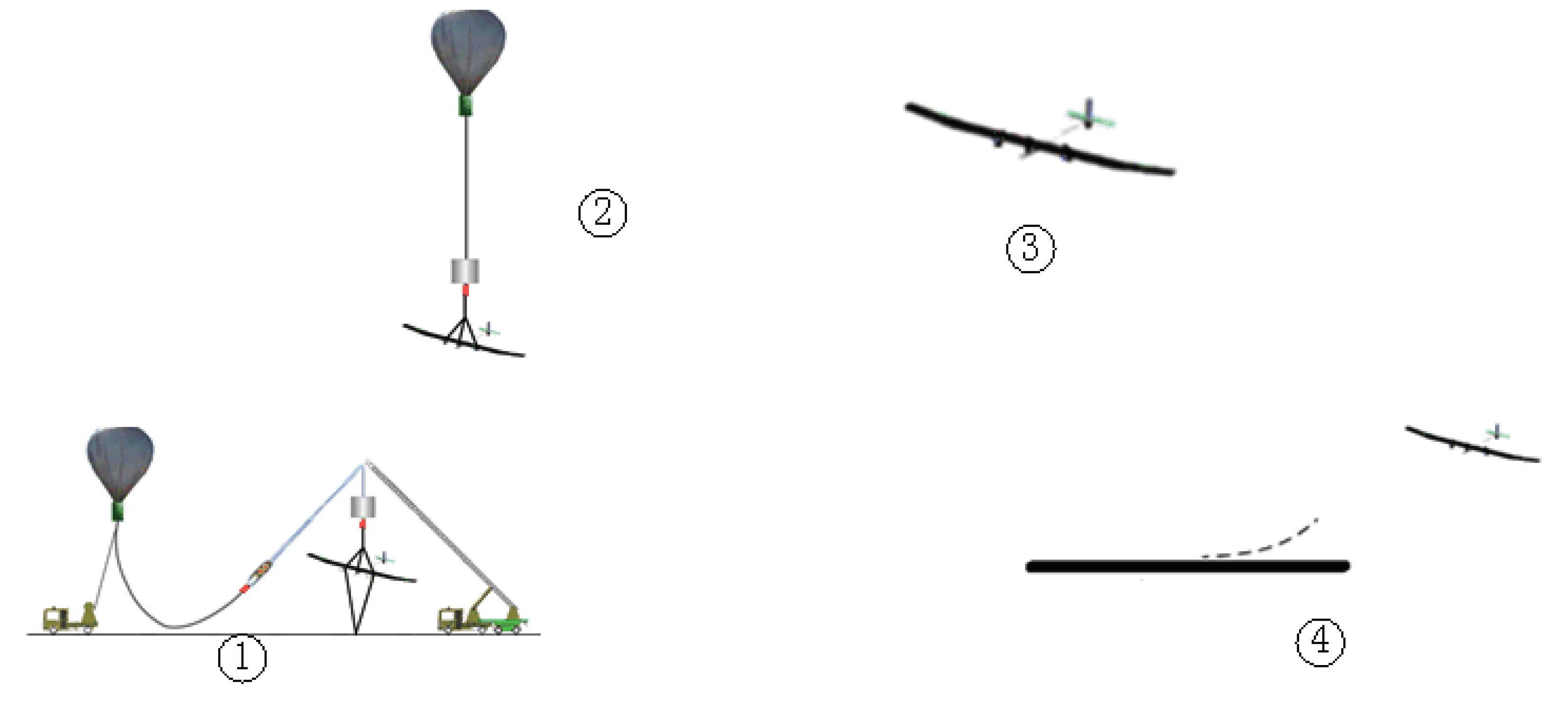
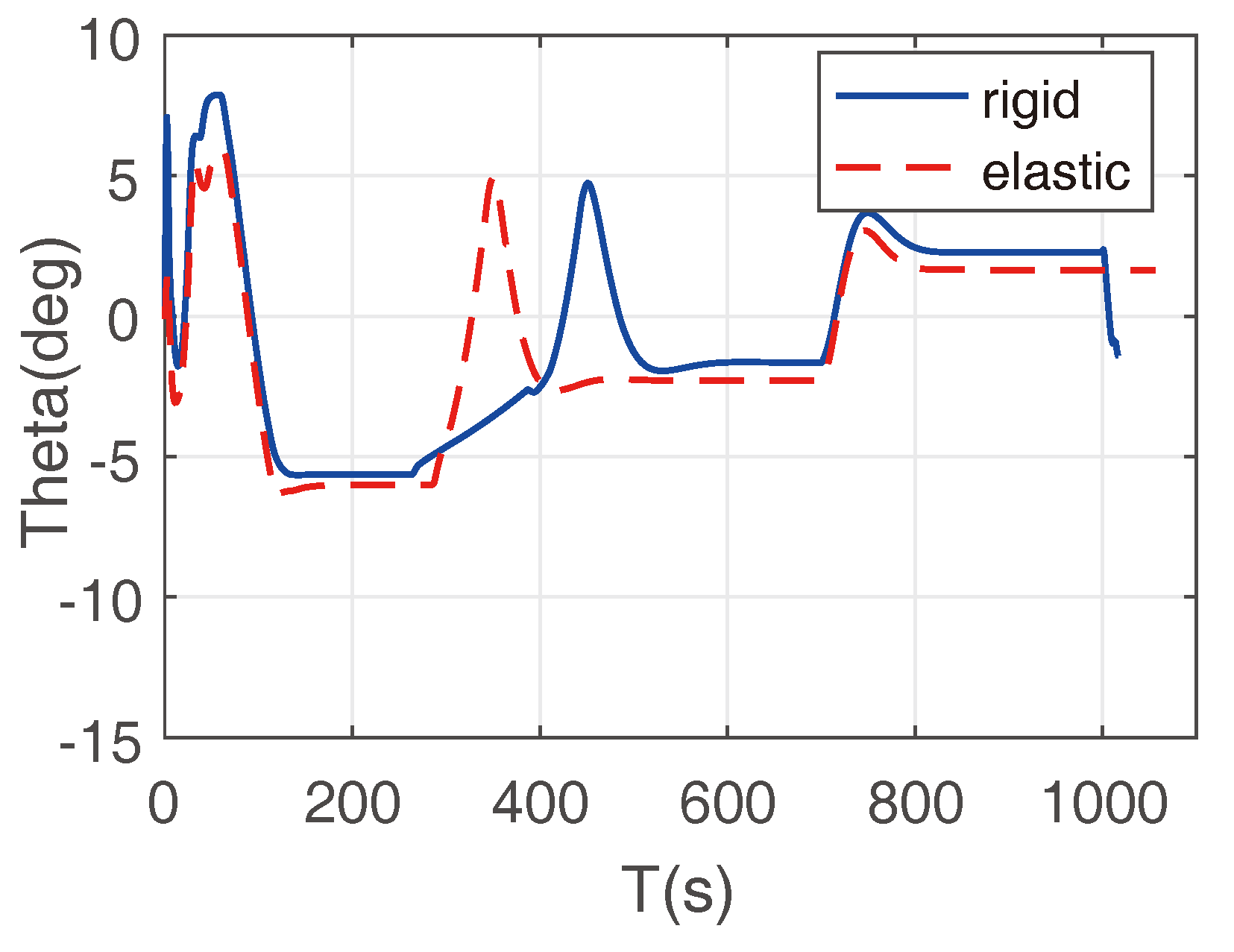
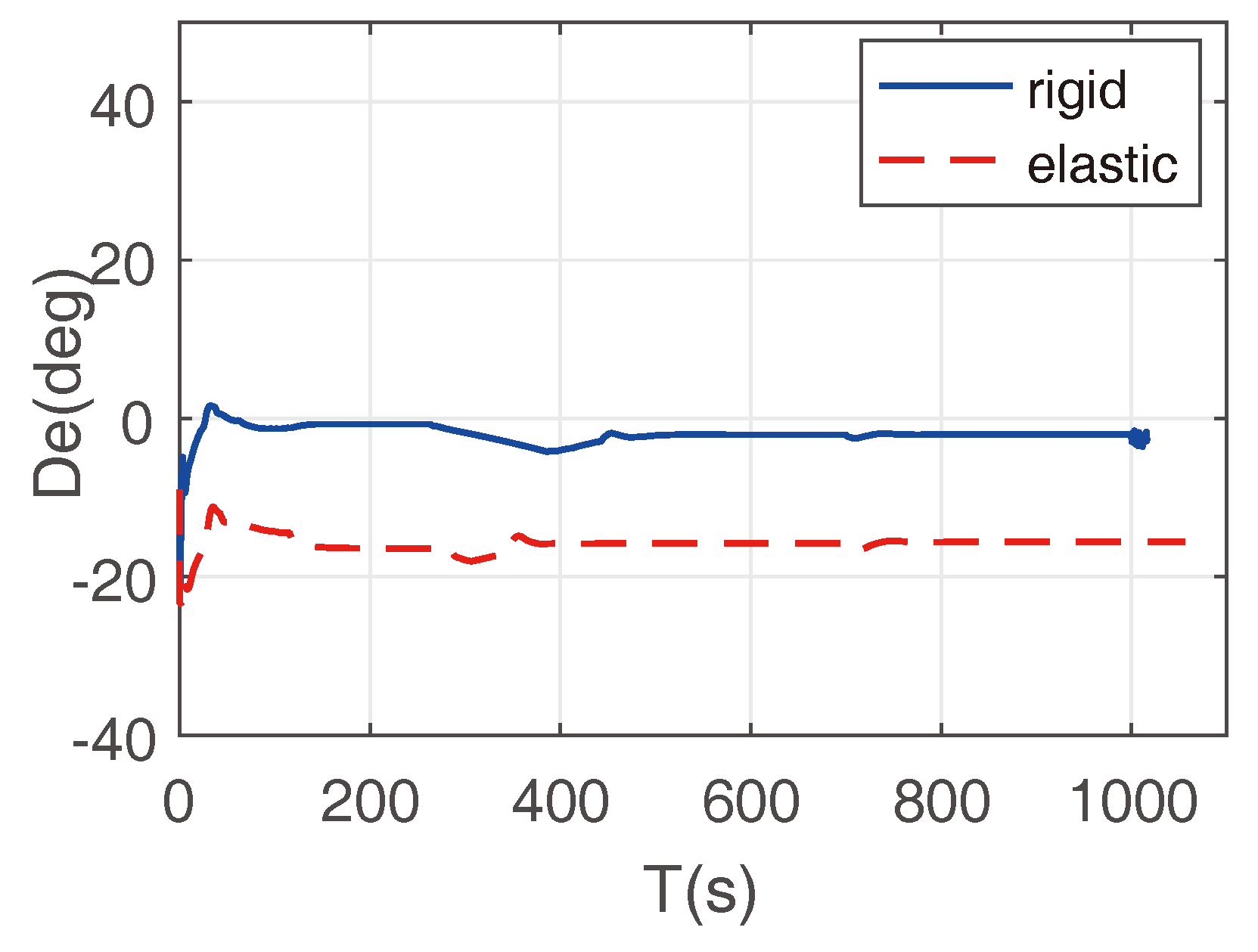


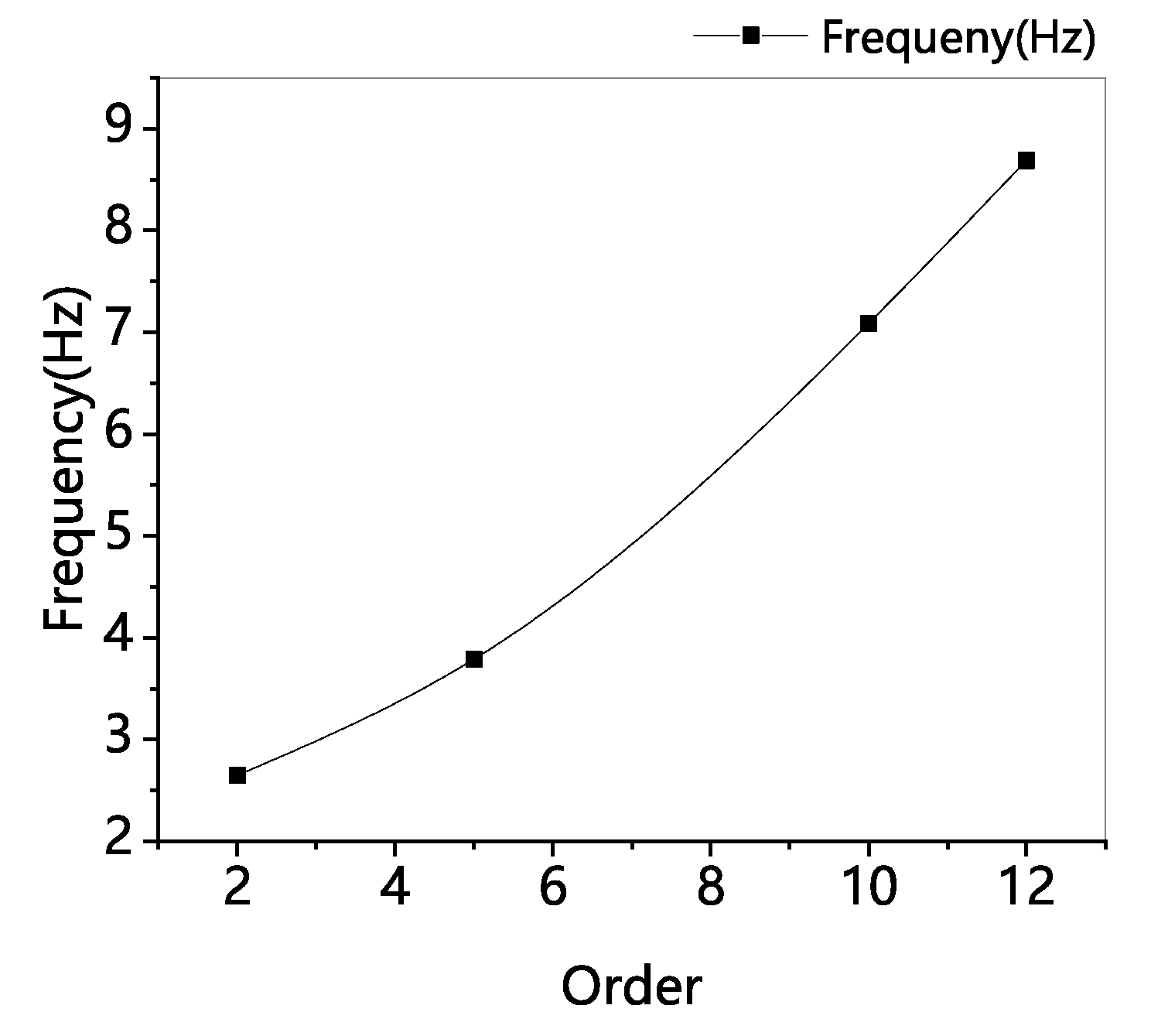
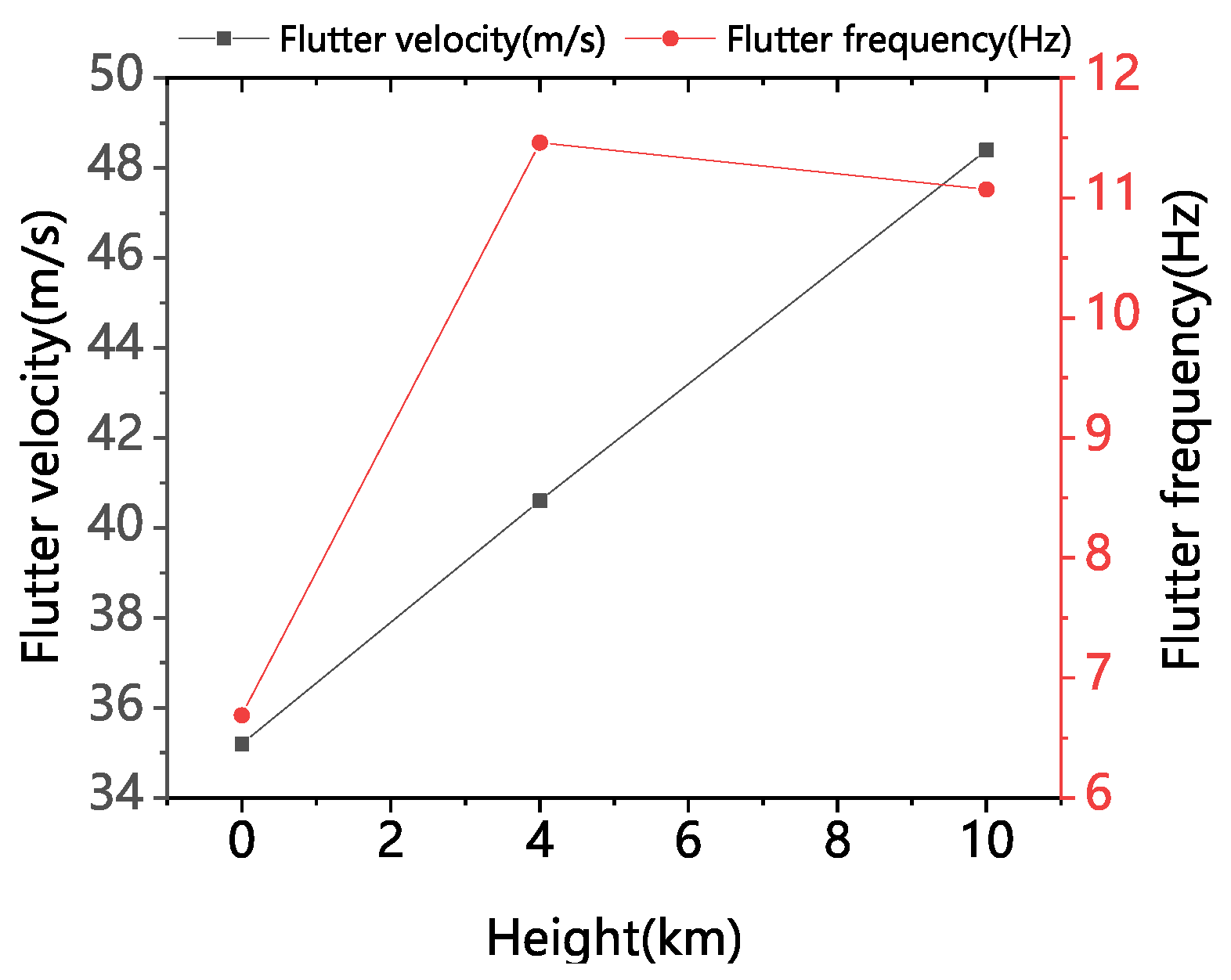
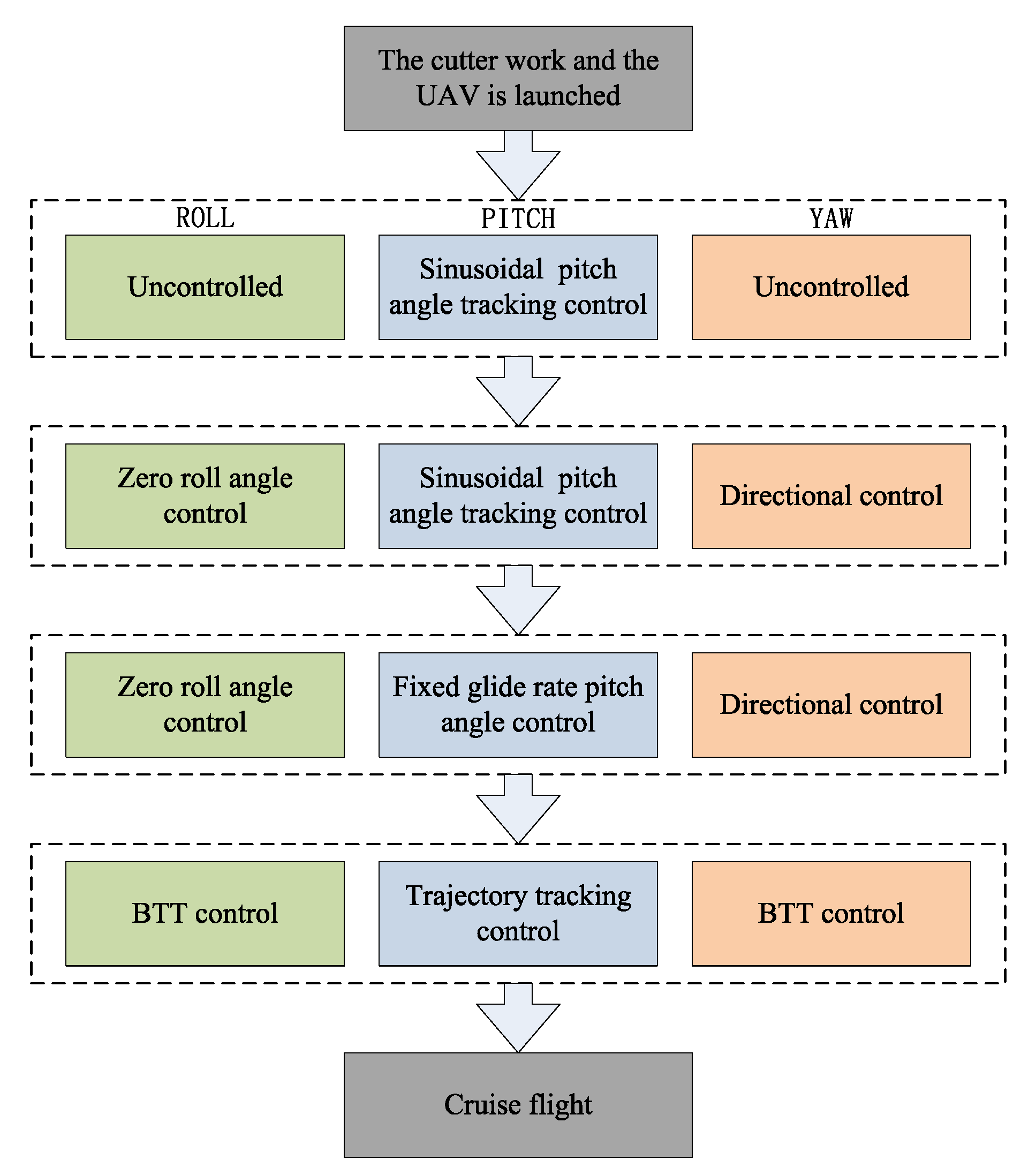




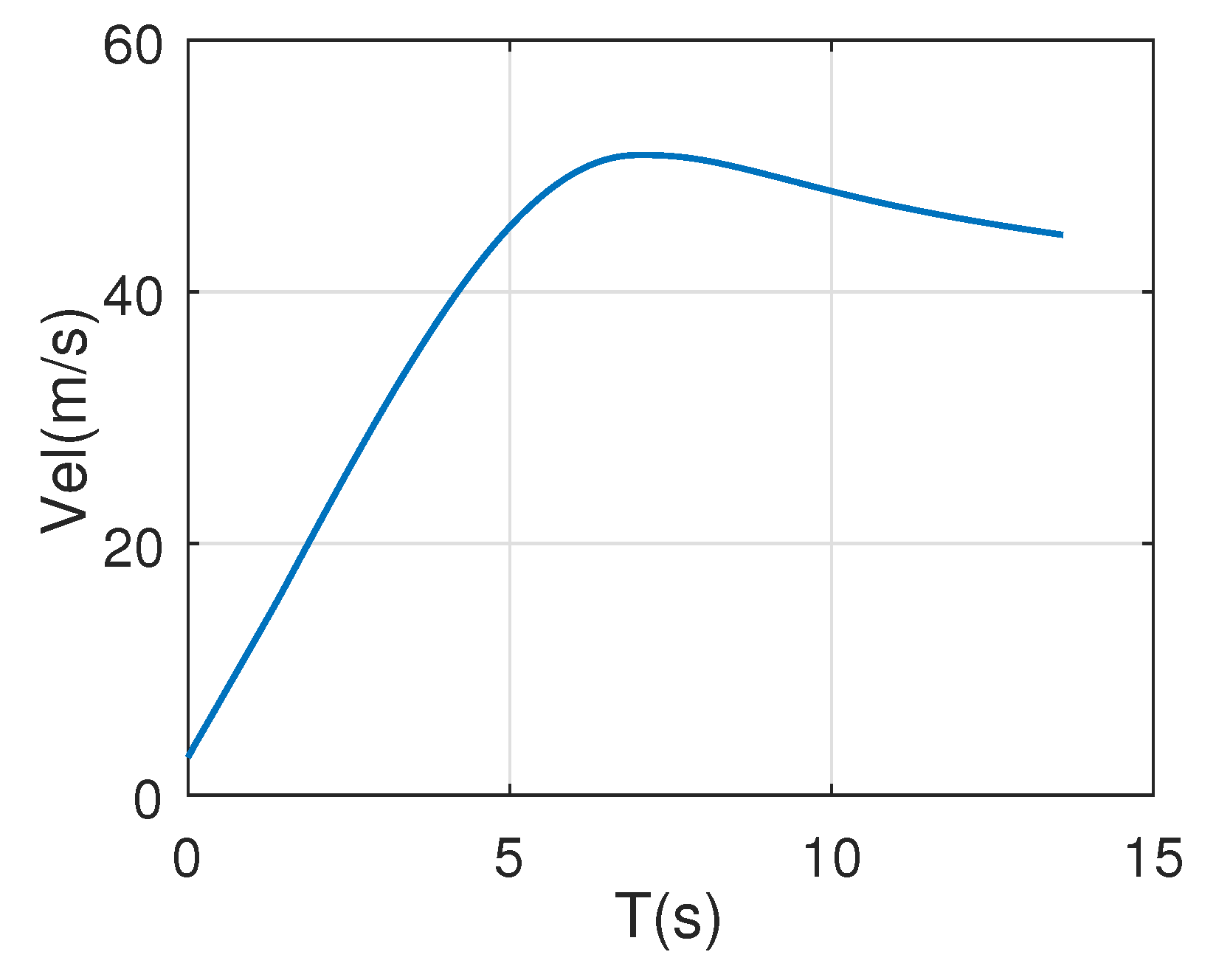
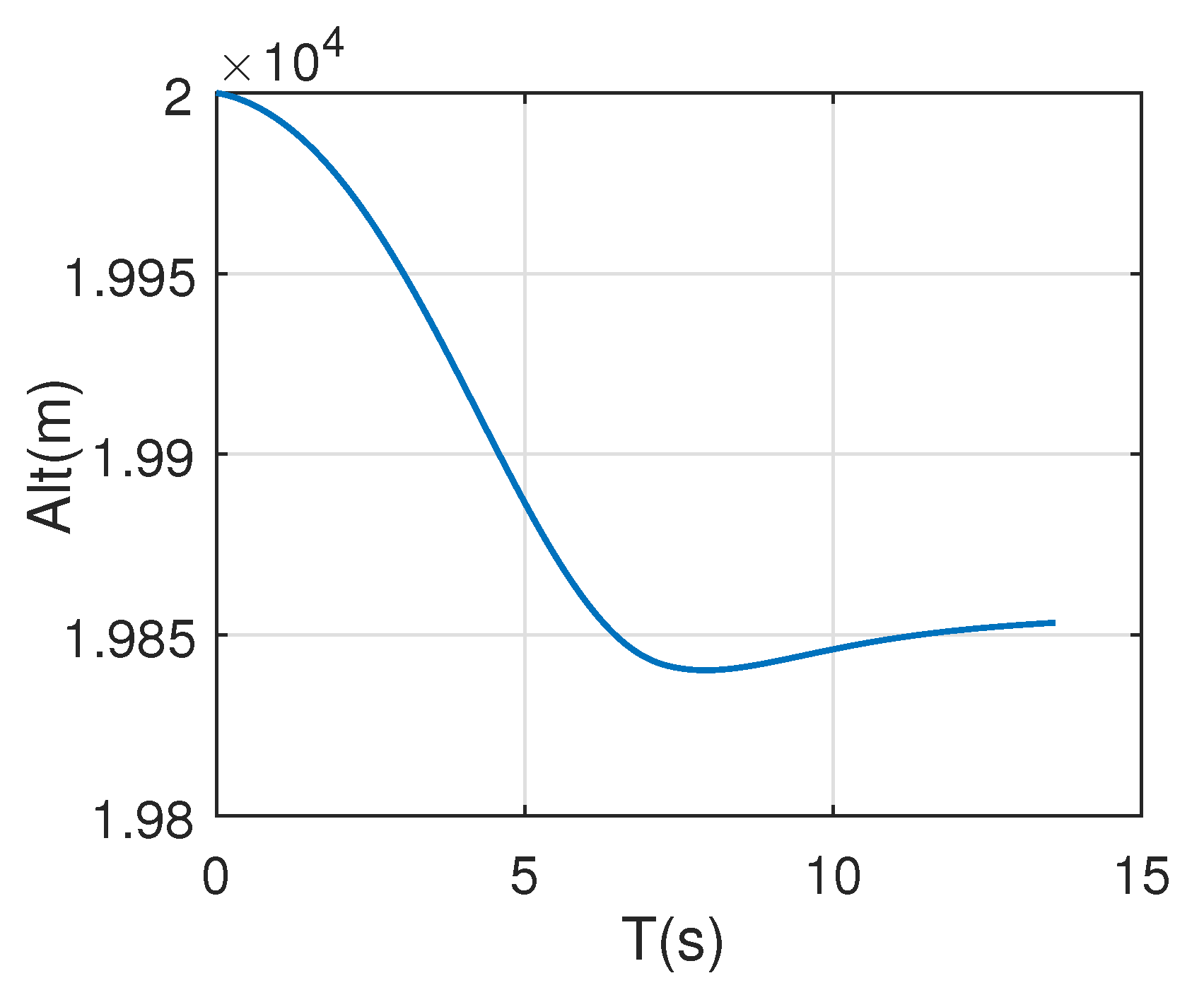


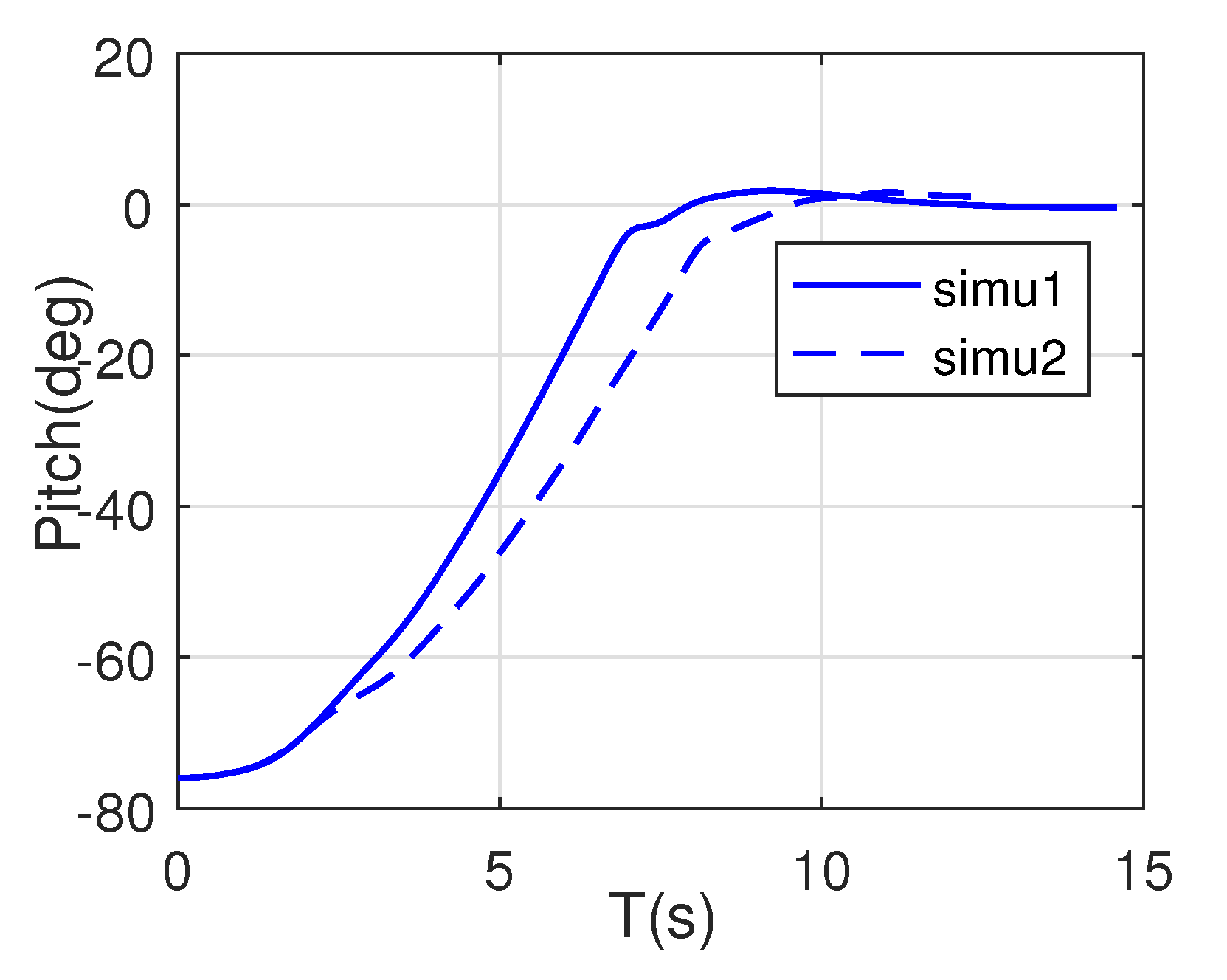
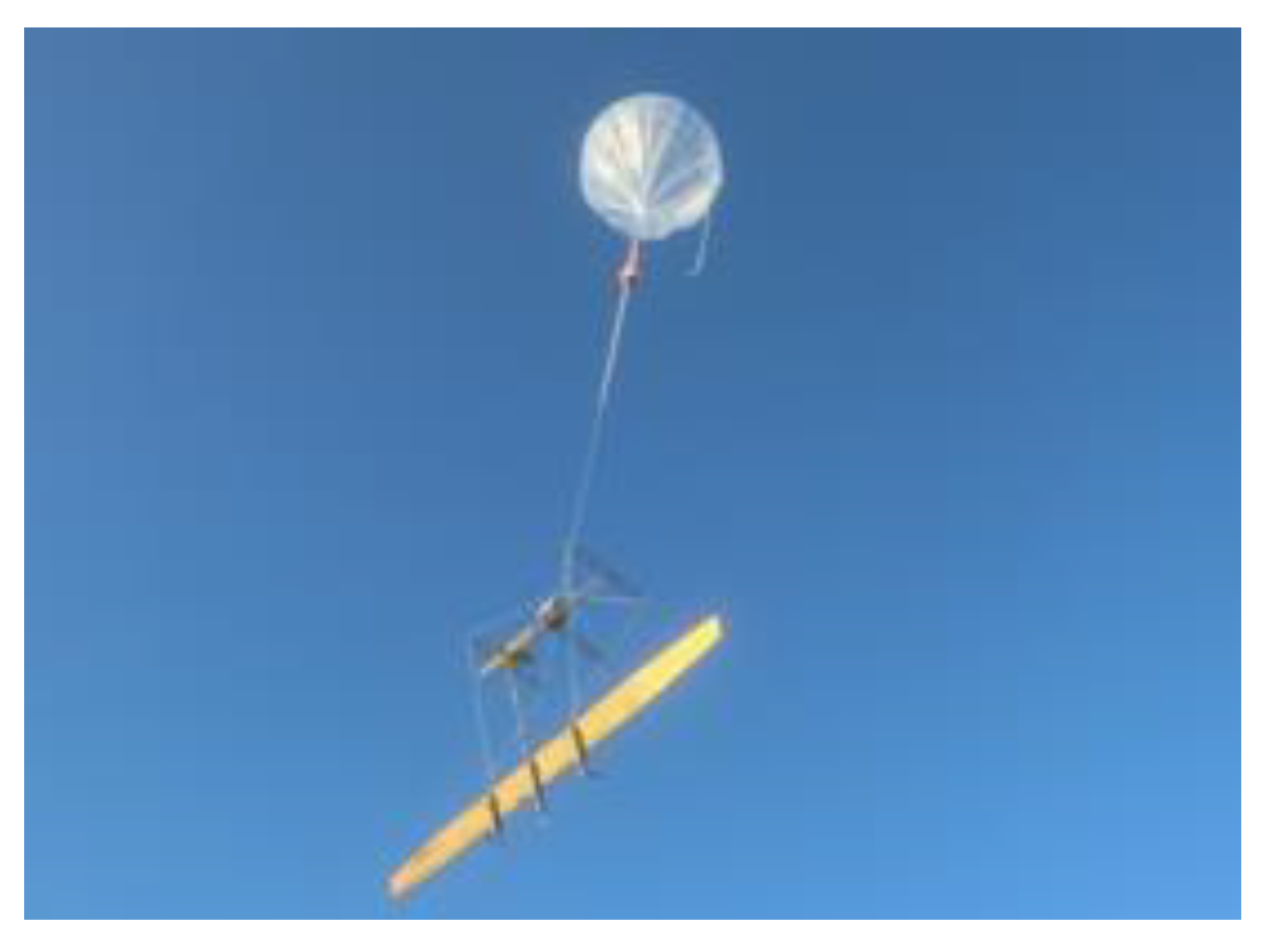
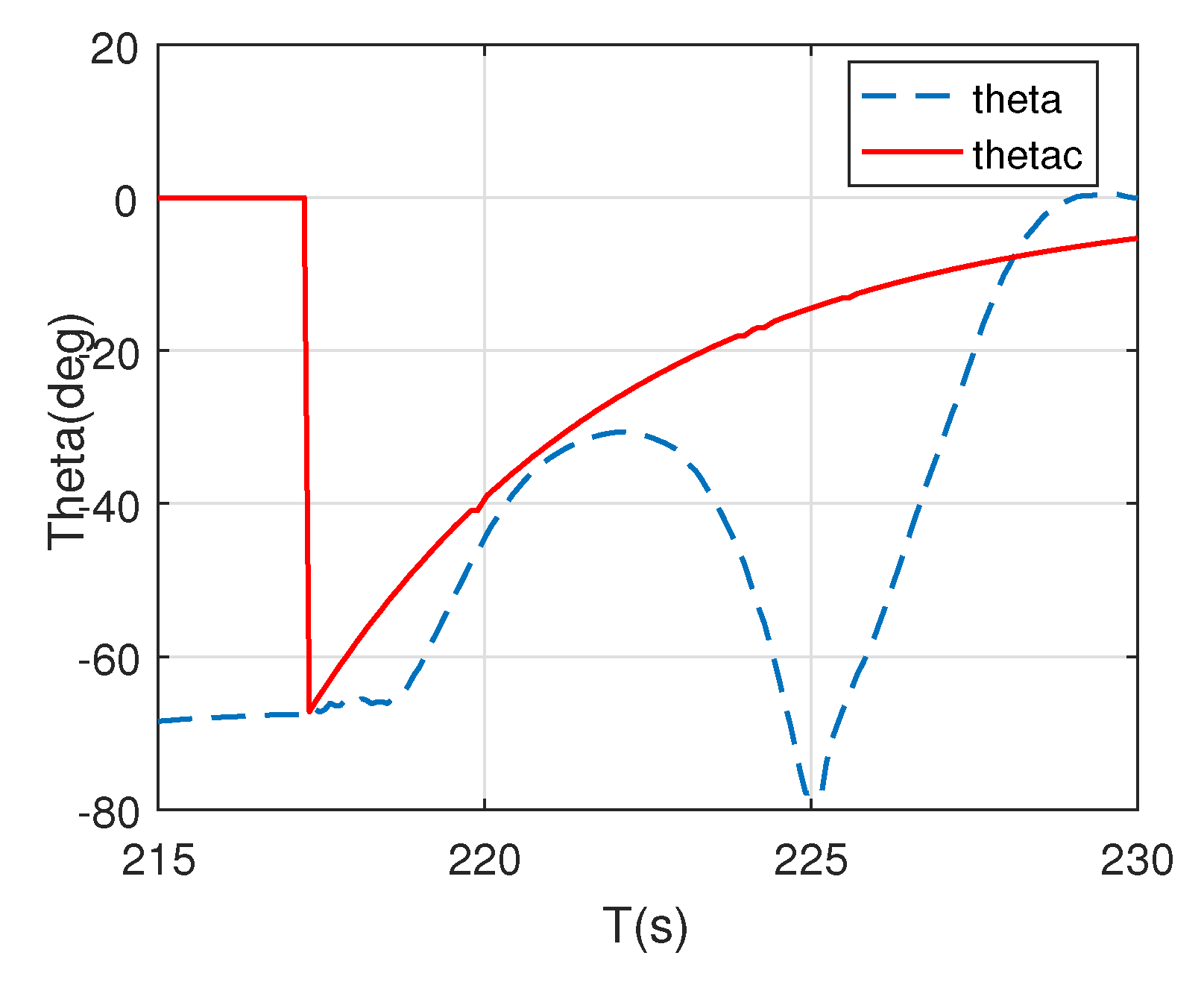
| Test | Time | Country | Launch Height | Launch Aircraft |
|---|---|---|---|---|
 | 2007 | Italy | 20.2 km | FTB-1 Castore |
 | 2014 | USA | 54.9 km | LDSD |
 | 2015 | Japan | 30.5 km | NWM/LBM |
 | 2017 | USA | 6.0 km | WHAATRR glider |
 | 2017 | Spanish | 25 km | Bloostar balloon rocket |
 | 2018 | China | 10/20 km | D18 Series |
 | 2019 | USA | 30.0 km | HiDRON UAV |
 | 2022 | USA | 31.39 km | STV-2 Reentry Capsule |
| Characteristic Roots | (m/s) | T (s) | (s) |
|---|---|---|---|
| 0.1912 | 2.2452 | 0.0852 | |
| 17.1147 | 16.5043 | 1.037 |
Publisher’s Note: MDPI stays neutral with regard to jurisdictional claims in published maps and institutional affiliations. |
© 2022 by the authors. Licensee MDPI, Basel, Switzerland. This article is an open access article distributed under the terms and conditions of the Creative Commons Attribution (CC BY) license (https://creativecommons.org/licenses/by/4.0/).
Share and Cite
Hu, Y.; Hu, Y.; Ding, X.; Zeng, G.; Guo, J. An Adaptive Launch Control for Balloon-Borne UAVs with Large Wingspans. Appl. Sci. 2022, 12, 10992. https://doi.org/10.3390/app122110992
Hu Y, Hu Y, Ding X, Zeng G, Guo J. An Adaptive Launch Control for Balloon-Borne UAVs with Large Wingspans. Applied Sciences. 2022; 12(21):10992. https://doi.org/10.3390/app122110992
Chicago/Turabian StyleHu, Yanpeng, Yanfei Hu, Xiaomiao Ding, Guannan Zeng, and Jin Guo. 2022. "An Adaptive Launch Control for Balloon-Borne UAVs with Large Wingspans" Applied Sciences 12, no. 21: 10992. https://doi.org/10.3390/app122110992
APA StyleHu, Y., Hu, Y., Ding, X., Zeng, G., & Guo, J. (2022). An Adaptive Launch Control for Balloon-Borne UAVs with Large Wingspans. Applied Sciences, 12(21), 10992. https://doi.org/10.3390/app122110992






